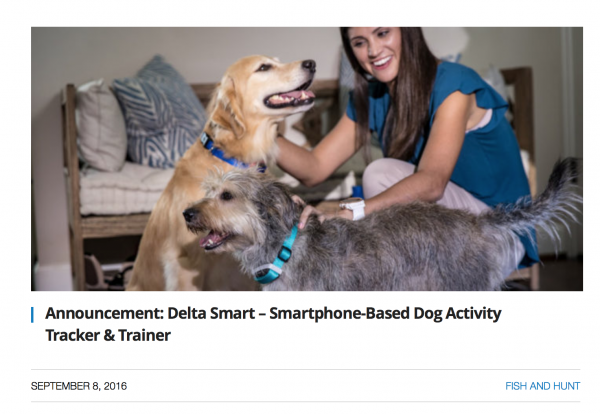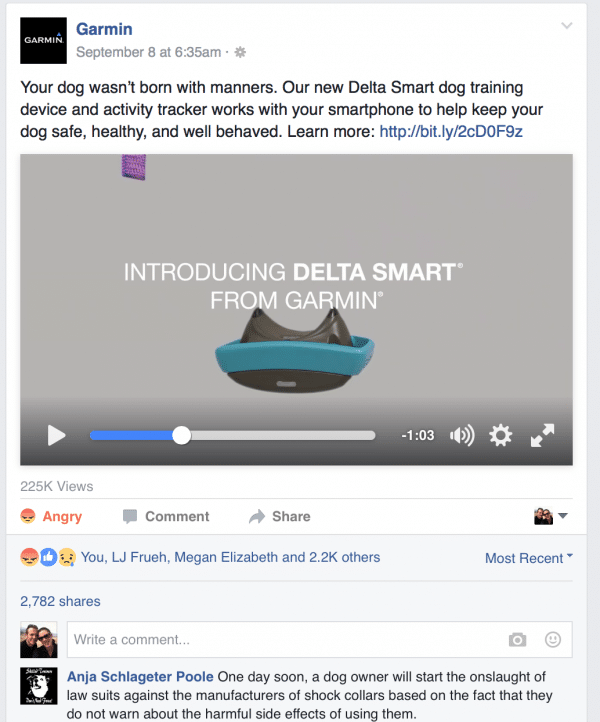I have been a runner for almost 20 years. In all that time, I have been loyal to a single running watch – the Garmin Forerunner. I’ve had four of them. So when I saw on Facebook that Garmin had a new product for dogs called the Delta Smart dog activity tracker and “trainer” (aka shock collar), to say that I was disappointed is an understatement.
As a dog trainer with extensive studies in animal behavior, I am a strong advocate of positive reinforcement training, which involves rewarding the behavior you like and ignoring or redirecting the behavior you do not like. Shock collars (or training collars or e-collars as they are often called) do not fit into this category and are based on the principle of causing the dog discomfort until he stops doing what you don’t want him to do. These types of collars are banned in other countries and are not supported scientifically.
Your dog will learn better when you teach him what you want him to do instead of punishing him for what you don’t want him to do. Dogs aren’t born understanding commands — you need to teach him.

Screenshot from Garmin.com.
Not to mention that we want dogs to listen because they trust us and because good things happen when they listen to us, not because they are afraid of the consequences if they don’t. Putting in the time and effort to train your dog through relationship building and trust is much more reliable and will be a positive experience for both of you.
Garmin says that its Delta Smart collar helps “keep family dogs safe, healthy, and well behaved” and will “help make your dog a happier and more enjoyable member of the family.” But how do they keep family dogs safe and healthy by using fear and pain to get them to “listen” to you? Is your idea of an enjoyable family member someone who sits in the corner by themselves because they are afraid to move or get near anything?
Garmin is a GPS company that is darn good at what it does in the field of outdoor activities, but it seems to be ignoring the overwhelmingly negative response to its newest and first smartphone-controlled training product. The last time I checked, the company’s Facebook announcement had over 1.5K angry reactions, and over 2,000 comments, almost all of which are negative. Ted Gartner, a Garmin spokesperson, was apparently surprised by the response and told the Washington Post, “We’ve been selling these products for quite some time. These sorts of tools have really, really been able to save the relationship between a dog and a family. That’s what we’re all about.” Note to Gartner: Training and working with your dog or going to training classes with your dog is more likely to strengthen and save a relationship.
Also, I know many people (including myself) did not realize that Garmin was already selling shock collars, or the ban and outrage would have come sooner. From now on, I will surely do my due diligence with any brand that I support.

Screenshot from Garmin’s Facebook page.
The main premise of this device, which attaches to your dog’s collar, is that you can control it from your smartphone. It doesn’t have the remote that traditionally comes with this type of collar. If you can’t imagine what problems could come from that, here are a few: What if the app freezes? What if your child gets ahold of your phone and accesses the app? What if your Bluetooth glitches and there is a delay between the time you push the button and the time your dog is shocked (which could lead to your dog getting shocked when she is doing nothing wrong at all)? All of these situations could lead to a very scary and harmful situation for the dog. The well-respected International Association of Animal Behavior Consultants (IABBC) recently released a position statement about why it is against bluetooth and smartphone-controlled training devices.
One of the main functions and points marketed at Garmin’s core audience is that the collar is a “virtual leash” for hiking with your dog. While this may sound like a great idea, as noted above, so many things can go wrong, but just a couple of things could be: The collar could malfunction, the app might not work, your dog might get scared when she is shocked and run into the road or even farther away, or if your dog doesn’t listen, she could get hurt or injured by another dog/animal. You want your dog to come when called because it means good things, not because they want to avoid pain or are afraid of the consequences, so take the time to work with your dog yourself. For our tips on training your dog off-leash, check out this article on our sister site, Lucky Puppy.

Training your dogs to be off-leash is much more reliable than using a shock collar. (Photo by Abbie Mood)
The device also works as an anti-bark collar, which you can set to “stimulate” (aka shock) the dog for barking. Have you ever known a dog who “talks?” The bark collar doesn’t just stop the barking, but can absolutely crush the spirit of an otherwise happy dog who uses his voice to communicate with his people. Not to mention a bark collar can physically hurt your dog from being repeatedly shocked if he ignores it.
I know that barking is a tricky, difficult, and annoying issue. It’s so easy to just slap a collar on and call it a day, but automatic training devices should never be an alternative to actually training your dog. Training your dog when to bark is much more reliable than your dog being afraid to bark.
The only feature that the device has that I am interested in is the GPS function, which allows you to see what your dog does during the day. Unfortunately, Garmin is using the function to also shock dogs for getting too close to furniture they shouldn’t be on, or for getting too close to the boundaries of your yard. I can’t say this enough – take the time to train your dog! If you can’t watch your dog, he shouldn’t be alone in an un-fenced yard. Even taking out the part about the shock collar, the collar doesn’t stop other animals from coming into your yard, putting your dog at risk for injury or worse.
If you think the GPS feature is a good idea, but are against shocking your dog, check out this petition on Change.org, asking Garmin to remove the shock feature and instead use the product as a GPS enabled collar only.
As I mentioned before, I’ve been a loyal customer to them for my entire running career, but unless they decide to change this product, I’m done.
The post Why Garmin’s New Smartphone-Controlled Shock Collar Is a Bad Idea appeared first on Dogster.
No comments:
Post a Comment